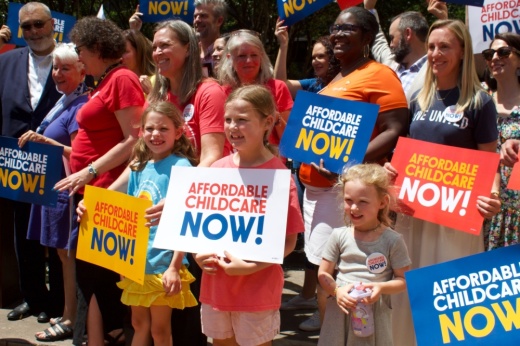After an outpouring of support from local child care advocates, Travis County commissioners approved a measure Aug. 13 to ask voters for a tax increase on the November ballot.
Property owners across the metro are being asked to support lowering annual child care costs. Currently, the cost for one child to attend daycare in Travis County is comparable with a year of tuition at The University of Texas at Austin, officials said.
If approved by voters, the increase would raise an additional $77 million annually—an estimated $288 total tax increase to the average homeowner—to fund a multi-pronged approach aimed at reducing the burden of child care costs for the community’s most vulnerable populations.
Whats happening?
The Austin region has the most expensive child care in Texas, according to a recent Texas Workforce Commission report, with the Dallas-Fort Worth metroplex trailing in second.
TWC data reveals the average cost of child care for just one kid in Travis County is an estimated $13,300 annually—comparable to the $13,500 cost of in-state tuition at UT Austin.“With tuition for early education being more expensive than rent and more expensive than college, low and moderate income families have to make really hard choices,” said Colin Swanson, the executive director of nonprofit early child care center Mainspring Schools.
Staff working on the commissioners’ initiative provided an update June 25 regarding several specific programs that would enhance access to affordable child care throughout the county that will be brought to voters:
- Increase subsidy spots in early childhood daycares; create incentives for providers to offer reduced-tuition spots
- Increase after-school and summer-care spots
- Expand nontraditional-hours child care—options outside the regular 9-to-5 workday for parents who work atypical hours
- Cover gaps in state subsidy funding
These programs are expected to create an estimated 9,800 additional child care opportunities for kids countywide by both increasing subsidy slots, and regular full-tuition after-school and nontraditional care slots, according to county documents.
Recent census data indicates there are an estimated 298,634 kids under the age of 19 living in Travis County, with 72,531 under the age of five—one of the primary populations targeted by the Creating Access for Resilient Families, or CARES, initiative.
The why
The rocky state of child care is nothing new, said Cathy McHorse, an early childhood consultant and advocate with the Affordable Child Care Now coalition. The industry was facing hardships even before the pandemic shut downs, she said.
The problem is multifaceted, she said, describing a systemic breakdown in the child care ecosystem.
“The limited investment by our state in child care subsidies means that right now, we have a growing waiting list of over 5,000 children locally, with a two-year wait," McHorse said. “The challenges of affordability are also making it difficult to recruit staff.”
A lack of state investment is one reason for the long wait lists for child care financial assistance in Travis County, said Cody Summerville, chief executive officer of advocacy group Texas Association for the Education of Young Children.
“One of the drivers of the waitlist, not just in Travis County but across the state, is that the state of Texas currently only invests what is the minimum requirement by the federal government into child care,” Summerville said.
Federal relief dollars initially helped stave off the economic hits for child care providers, Summerville said; however, pandemic funding expired at the end of 2023.
Today, state subsidy funding often does not cover the full cost of tuition, leaving providers or families responsible for the remaining balance. Just under half of providers, or 45.5%, offer subsidy enrollment in the capital area, according to TWC 2023 data.
Another significant barrier to affordable child care stems from staffing issues, Summerville explained. Child care is a “labor heavy” industry, where operators spend between 60%-80% of operating costs on their workforce, he said.
“The average wage of a child care teacher in the state of Texas is about $12 an hour,” Summerville said. “As you can imagine, $12 an hour just is not very competitive in today’s job market, and so it is tricky to retain your workforce with those low wages, and it’s also hard to replace your workforce as turnover occurs.”
Without a full staff, child care centers are unable to operate at full capacity, which leads to lower enrollment and lower revenue for a business that has many fixed costs, like rent and power.
Operating a reduced capacity also leads to increased waiting lists for families looking for open spots.
In Travis County, there are 14 ZIP codes that do not have enough child care providers or capacity to service the children living there, something known as a child care desert.
“The challenges of affordability are also making it difficult to recruit staff,” McHorse said.
How it would work
If voters approve the funding, county officials’ plans emphasize increasing financial-assisted spots, followed by expanding after-school and summer programs.
“This is one of those situations where we really are building a plane as we’re flying it,” Korey Darling, planning manager at Travis County Health and Human Services, told commissioners June 25.
Darling said there is still a lot of work needed for programs to be implemented by their projected timeline, starting as early as summer 2025 in a phased roll-out.
Put in perspective
The impacts of unaffordable child care reaches across both low- and high-income levels, Austin parent Geno Gargas said.
“I personally wouldn’t support this tax increase... My wife and I have already made a large sacrifice,” Gargas said. “The choice after our first son was born, based on her income level, was we either pay for daycare or she stops working. The cost was pretty much the same.”
A supporter of the tax rate increase, local North Austin parent Erin Gurak said this is an issue that impacts everyone.
“I think it’s a really important issue that is not always talked about,” Gurak said, “[Child care has become] a choice that I think sometimes families might feel boxed into making... Do we work and try to supplement and pay for multiple children in child care, or exit the workforce?”
The outlook
Gurak acknowledged that people without children might wonder, "What's in it for me?" However, she emphasized that the issue affects everyone.
“It’s a workforce issue, an economic development issue, a supporting your community issue,” Gurak said. “A rising tide lifts all boats.”
Texas’s economy loses about $9.4 billion annually due to breakdowns in child care, according to the U.S. Chamber of Commerce.
On the other hand, Gargas said local tax increases are really starting to add up, saying it feels like getting “nickel and dimed” every year.
Travis County's base tax rate increase plus the child care tax, if approved by voters, would cost the average homeowner $288 more per year.
Travis County residents can weigh in on the proposed tax increase during this November’s election. Community members have until Oct. 7 to register to vote.
Other important dates to know include:
- First day of early voting: Oct. 21
- Last day to apply for mail-in ballot: Oct. 25
- Last day of early voting: Nov. 1
- Election Day: Nov. 5





